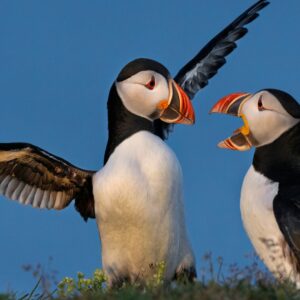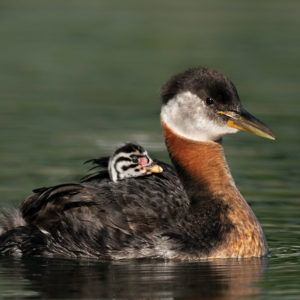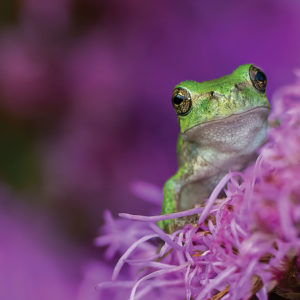The American Bison
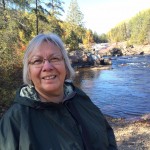
Valerie Assinewe,
Guest Blogger
This blog was written by guest blogger, Valerie Assinewe.
Prior to the arrival of Europeans, up to thirty million American Bison roamed across this continent. It is estimated that by 1888 only eight bison remained in Canada and 85 in North America. Settler expansion and commercial hunting virtually wiped out the American Bison. This month’s photo in our Nature Canada calendar is living proof of what can be achieved through thoughtful and concerted conservation efforts.
Habitat and Range:
The Plains Bison (Bison bison bison) once roamed over the entire Great Plains of the continent. Today, they are found in protected meadows and grasslands from British Columbia to Manitoba and as far north as the Yukon and southwestern Northwest Territories.
The Wood Bison (Bison bison athabascae) is endemic to Canada. Historically, they ranged through much of western Canada’s mixed woodlands. Thanks to active recovery efforts, today there are nine wild Wood Bison subpopulations ranging in Alberta, British Columbia, Manitoba, Yukon and Northwest Territories, occupying about 5% of their original range.
Appearance:
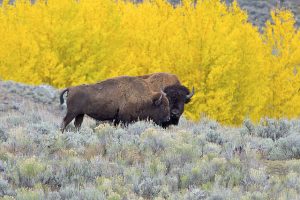
American Bison and calf in autumn. Photo by Arturo de Frias Marques (CC BY-SA 4.0)
The American Bison is North America’s largest terrestrial animal. From any distance, the bison looks formidable with its huge head and shoulder hump. A mature bull may stand up to 2 m in height, measure 3.8 m in length, and can weigh as much as 880 kg. The mature female is smaller and shorter than the male.
The fur color is brown, varying slightly from the front to the back of the animal. The hair is longer in the front than in the rear. This variance in hair length is most noticeable in males.
The horns are black, curving upward and inward and ending in a sharp tip. The hooves are black and circular in shape.
Despite their impressive size, the American Bison can gallop at speeds of up to 56 km/hr and are good swimmers.
Diet:
Bison feed mainly on sedges and grasses, but also on the leaves and bark of trees and shrubs (primarily willow) and lichens. They also need to find water every day.
A healthy mature bison is not likely to succumb to predators. It is the sick, injured, young or old that most often fall prey to Wolves, Grizzly Bears or Cougars.
Reproduction:
American Bison live and travel in groups. For most of the year, herds are divided by sex, with females and calves in one herd and males in another. When the breeding season begins in the summer, the mature males temporarily join the female herd and begin looking for a mate. During rut, the bulls display their dominance with bellowing, wallowing and head-butting other bulls. Once a bull has found a female who is close to estrus, he will stay by her side until she is ready to mate. The pair may mate several times; then the bull moves on to another female.
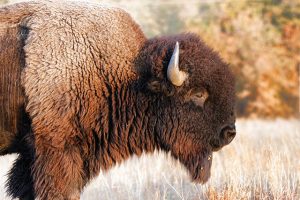
American Bison. Flickr photo by Larry Smith (CC BY 2.0)
In April or May of the following year, the female gives birth to a single calf. Newborn calves have a reddish, light brown coat, and lack the distinctive hump of the adult bison. They begin turning brown and developing the hump after a few months.
Calves are capable of walking and running within a few hours of being born. They are nursed for up to eight months, and are fully independent by the end of their first year.
Females are sexually mature in two to three years, and males reach maturity around age three. Bulls, however, do not usually breed until six years of age, when they have reached a size that enables them to compete with other bulls for access to females.
Bison live 15-20 years in the wild. Records show that some live to 40 years in captivity.
Some interesting facts
- Both Wood Bison and Plains Bison are considered by some to be subspecies of the American Bison, but their actual systematic status is unclear and controversial.
- The Plains Bison and the Woods Bison have some morphological differences. The most obvious is size: the Wood Bison is the larger of the two by 10-15%. This makes the Wood Bison the largest native land mammal in North America. Other visual differences include:
- The Plains Bison has a rounded hump, while the Wood Bison has a taller and squarer hump;
- The frontal hair on the Wood Bison is in long forelock strands, whereas the Plains Bison has a matte of dense hair standing in an “afro” style;
- The beard of the Woods Bison is thin and pointed, while the Plains Bison beard is bell-shaped and pendulous;
- The Wood Bison cape has no demarcation, whereas the cape of the Plains Bison features a sharp demarcation; and
- The tail of the Wood Bison reaches its hocks; the Plains Bison has a shorter tail.
- From beard to tail, Indigenous peoples used every part of the bison. The meat provided sustenance; the hide provided clothing and shelter; and the bones, horn, sinew and fat provided tools. It is no wonder the American Bison figured large in First Nations cultures. Today the American Indians are a significant force in re-establishing healthy herds on their lands.
Today in Canada, there are ~2,200 Plains Bison and ~10,000 Wood Bison. While this resurgence is encouraging, the species are far from safe. In 2013, both were assessed as “Threatened” by the Committee on the Status of Endangered Wildlife in Canada (COSEWIC). The Species at Risk Act subsequently listed the Wood Bison as “Threatened.” The greatest threats remain loss of habitat and bison management. By supporting Nature Canada’s efforts to restore natural grasslands, you can be part of this ongoing recovery!

